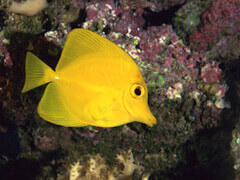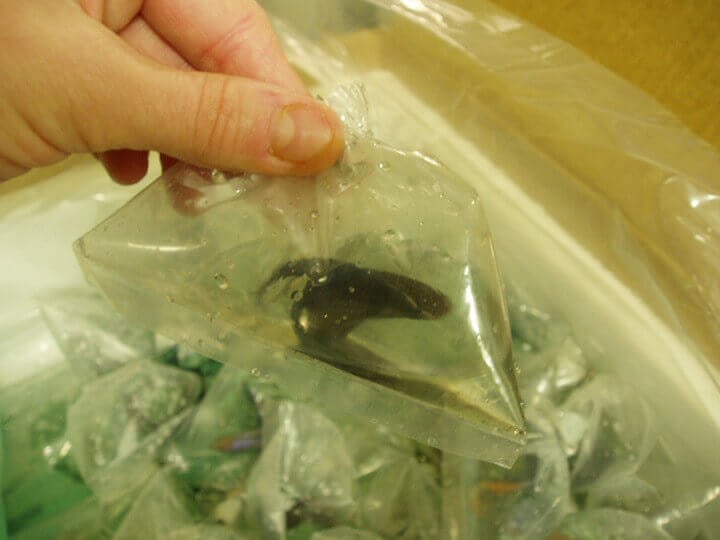 Fragile tropical fish, who were born to dwell in the majestic seas and forage among brilliantly colored coral reefs, suffer miserably when they’re forced to spend their lives in glass tanks. The same is true of river fish. Removed from their natural habitats and denied the opportunity to travel freely, they must swim around endlessly in the same few cubic inches of water.
Fragile tropical fish, who were born to dwell in the majestic seas and forage among brilliantly colored coral reefs, suffer miserably when they’re forced to spend their lives in glass tanks. The same is true of river fish. Removed from their natural habitats and denied the opportunity to travel freely, they must swim around endlessly in the same few cubic inches of water.
Where Fish Really Come From
The popularity of keeping tropical fish has created a virtually unregulated industry that catches and breeds as many fish as possible, with little regard for the animals themselves. While many species of coral are protected under the Convention on International Trade in Endangered Species of Wild Fauna and Flora, most of the fish who end up in aquariums are not.
An estimated 95 percent of saltwater fish sold in pet shops come from the wild, mostly from the waters around Fiji, Indonesia, the Philippines, and other Pacific islands. More than 20 million fish, 12 million corals, and 10 million other types of marine life—such as anemones, shrimp, and mollusks—are captured every year to support a $300 million worldwide “hobby.” Some species, such as the Banggai cardinalfish, have become endangered because of overfishing, a practice commonly employed to satisfy the aquarium industry.
Collectors douse the coral reefs with cyanide, which is ingested by the fish who live there, and as reported in Scientific American, “The resulting asphyxiation stuns some fish and sends others into spasms, making them easy to grab by hand or net.” Half the affected fish die on the reef, and 40 percent of those who survive the initial poisoning die before they reach an aquarium. Cyanide also kills the coral reefs themselves, and marine biologists rank it as one of the biggest dangers in Southeast Asian waters.
Approximately 90 percent of freshwater fish are raised on farms. Goldfish, for instance, are usually bred in giant tubs in facilities that produce as many as 250 million fish per year. These animals are sold to zoos, pet stores, and bait shops, and many are doomed to live in plastic bags or bowls, neither of which provides the space or oxygen that goldfish need. The city of Monza, Italy, banned keeping goldfish in bowls because the containers do not meet the needs of the animals and because, as one sponsor of the law pointed out, bowls give fish “a distorted view of reality.”
Some fish farms are seeking new market niches by creating fish breeds that would never occur in nature, treating fish as ornaments instead of living animals. Some breeders even “paint” fish by injecting fluorescent dyes into their bodies or altering their genetic makeup to make them more attractive to buyers.
Fish Can Speak, Make Tools, and Think
Fish have cognitive abilities that equal and sometimes surpass those of nonhuman primates. They can recognize individuals, use tools, and maintain complex social relationships. Biologists wrote in Fish and Fisheries that fish are “steeped in social intelligence, pursuing Machiavellian strategies of manipulation, punishment and reconciliation, exhibiting stable cultural traditions, and co-operating to inspect predators and catch food.”
Fish communicate with one another through a range of low-frequency sounds—from buzzes and clicks to yelps and sobs. These sounds, which are audible to humans only with the use of special instruments, communicate emotional states such as alarm or delight and help with courtship. The pumps and filters necessary in many home aquariums can interfere with this communication. “[A]t the least, we’re disrupting their communication; at worst, we’re driving them bonkers,” says ichthyologist Phillip Lobel.
What You Can Do
Please don’t support the tropical fish trade by purchasing fish. If you enjoy watching fish, consider downloading one of the many colorful and realistic fish-themed computer screensavers available on the Web. Don’t support businesses or fairs that give fish away in contests or promotions. In the United Kingdom, it’s illegal to give fish as prizes or sell animals to children under the age of 16, and guardians must provide a “suitable environment” for all animals. A similar law is in effect in Reggio Emilia, Italy.
Siamese fighting fish (Betta splendens), who are often sold as “decorations” or party favors, are fighting for their lives as their popularity grows. Pet shops, discount superstores, florists, and even online catalogs sell Siamese fighting fish in tiny cups or flower vases to consumers who are often uneducated about proper betta care. These tiny containers are not suitable for any fish.

Biologists say that there is no safe way to return captive fish to their natural environments—which are often located in a completely different region of the world—because of the difficulty in locating such a habitat and the possibility of introducing disease to the other fish there. Researchers have found many species of non-native fish, including predatory species, living off the coast of Florida, and they attribute the presence of these populations to careless aquarium owners. These fish pose a real threat to native species. Never flush fish down the toilet in the hope of “freeing” them, as seen in the popular movie Finding Nemo. Even if a fish survives the shock of the swirling water, he or she would die a painful death in the plumbing system or at the water treatment plant.
If you already have fish, you can make their lives easier by providing them with an environment that is as much like their natural habitat as possible. While captive fish can never enjoy natural lives, the following tips will help ensure that they are as happy as possible:
- Don’t overstock aquariums. You want to make sure that oxygen levels in the tank are sufficient for everyone living inside. Also, the more space that fish have, the happier and healthier they will be. Their needs vary, so check with an expert or consult a fish handbook to determine their requirements. For smaller species, one guideline is that you should provide a minimum of 3 gallons of water for every 1 inch of fish. Generally, no fish should be kept in a tank smaller than 10 gallons. (However, a single betta would likely be happy in a 5-gallon tank.) Larger fish, such as goldfish, should have an absolute minimum of 30 gallons per fish, some requiring much more. Treat tap water properly with a water conditioner before adding it to the aquarium, as most municipal water contains chlorine and chloramine, which will kill fish. Consult with a local tropical fish supply store to determine the proper conditioner to use.
- Once a tank is fully set up with a properly working filter, substrate, and decorations, the water must be cycled for several weeks before fish are added. This will allow time for beneficial bacteria to grow, which will be essential for breaking down toxic ammonia once fish are added. Adding small amounts of fish food to a newly set up tank will help start the nitrogen cycle, but consult your handbook for more detailed instructions. Use testing strips to monitor the process, and when the ammonia and nitrite levels have dropped, the tank will be ready for fish.
- Make sure that the water temperature is appropriate for the species of fish living in the tank. A vast majority of aquarium species are tropical, and their normal recommended temperature range is approximately 75 to 84 degrees, and 78 degrees is usually considered the ideal temperature. Nontropical fish, such as goldfish, prefer temperatures of 68 degrees or less. Because of this, tropical and nontropical fish should not be kept in the same tank together. Check with a fish supply store for information that is specific to the type of fish that you’re keeping. Automatic aquarium heaters monitor the water temperature and turn the heater on and off as needed. Attaching a small thermometer to the tank will help you ensure that the heater is functioning properly.
- Beneficial bacteria in the tank convert fish waste into nitrates, which can be removed only with regular water changes. As a rough estimate, about 10 to 20 percent of the water in a tank should be removed once every one to two weeks. More or less water may need to be removed depending on the size of the tank and the number of fish inside, but the tank water should never be emptied completely. Don’t forget to treat the new water with water conditioner before adding it to the tank. During regular water changes, be sure to clean your filter media by swishing it around in the water you’ve just removed from the tank to remove buildup, as running your filter media under new water can kill the helpful bacteria that have grown on it. Soaps and harsh chemicals should never be used to clean a tank, as these substances are deadly to fish.
- Create many places for the fish to hide and explore. Gravel, plants, and other decorations should be rinsed off before being placed in a tank. As a best practice when stocking a tank, use only items specifically meant for aquariums.
- Be aware of the environment outside the aquarium. Suddenly switching on a bright light in a dark room can startle fish, and vibrations from a television or a stereo can alarm and stress them.
- Keep all harmful chemicals away from the aquarium. Cigarette smoke, paint fumes, and aerosol sprays can be toxic if they are absorbed into the water.
- The aquarium should be in a spot where temperature and light are constant and controllable. Tropical fish supply stores may be able to advise you on the best amount of light for the fish you are keeping. Remember that direct sunlight and drafts from nearby doors or windows can change the water temperature or cause excessive algae growth, and fumes from a nearby kitchen or workshop can injure the fish.
- Don’t overfeed fish. Uneaten food and waste material are broken down by the bacteria in the tank, but too much will overload them, and the levels will become toxic. You should provide only as much food as your fish can eat in three to five minutes.
- Fish can be medicated, anesthetized, given shots, and operated on, just like other animals. If a fish seems sick or lethargic, you should consult the care booklets that you purchased and seek advice from an expert or a veterinarian. It’s important to note that many common ailments are treatable at home. Sick fish can be separated from the others in an established quarantine tank until they have rebounded to full health.
- Most fish enjoy companionship. Consult a handbook or an expert to determine the needs of each species. If you have a single fish, check with friends and neighbors to find another loner to adopt—but don’t support the fish trade by going to a dealer. Monitor your fish to ensure that they’re all living peacefully together. If you find that one fish is being picked on or that fish are acting aggressively, use another established aquarium to separate the fish. If this isn’t feasible, you can purchase a clear plastic divider from a supply store or catalog to separate the fish. Note that male betta fish are aggressive with other male bettas and that a clear divider is not enough to separate them—they may constantly try to fight through the divider, which will cause chronic stress and likely illness. Fortunately, they are often capable of co-existing peacefully with most other species of fish.
Fish are complex animals, and caring for them properly requires far more knowledge, supervision, equipment, and patience than most people realize.
This page is only a very brief list of guidelines. Please purchase a fish care book well before you make the decision to take on the responsibility of caring for any fish.





